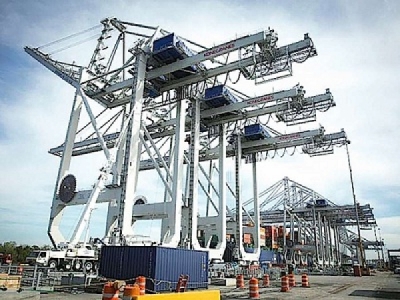
Posted on April 11, 2017
By Winston Skinner, The Newnan Times-Herald
Work is progressing on the deepening of the port of Savannah, but the improvements are accompanied by concerns about cost overruns and a lengthened work schedule.
The Savannah Harbor Expansion Project involves dredging the harbor at the coastal city so it can service larger cargo ships coming through the Panama Canal. The Panama Canal, which first opened in 1914, was expanded and re-opened for larger Post-Panamax ships on June 26.
Many ports around the world are not deep enough to take the new ships, which can carry larger amounts of cargo. Georgia leaders – Republican and Democrat – joined forces in an effort to improve the port to avoid Savannah being passed over by shippers for better equipped ports.
The Port of Savannah, which administratively includes both Savannah and Brunswick ports, is of vital importance to Coweta County’s economy. Many local businesses import products or raw materials that enter the United States via the port. There also are Coweta companies that export products through the ports to destinations around the globe.
The Port of Savannah has commissioned the first of four new ship-to-shore cranes at its Garden City Terminal. Each new crane can lift 65 long tons to a height 152 feet above the dock.
“Expanding our capabilities means we are able to grow along with our customers, and adjust to changes in the logistics marketplace, such as increasing vessel sizes,” said Ed McCarthy, chief operating officer for the Georgia Ports Authority.
Designed by Konecranes of Finland, the enormous cranes can work the largest ships calling on the U.S. East Coast.
Garden City Terminal will add another crane every two weeks. The final crane should be in place around the end of April. The four Post-Panamax cranes join 22 others already being used in Savannah.
Port officials said another four Neo-Panamax cranes are on order and will be commissioned in 2018. The growing crane fleet, working over nearly 10,000 contiguous feet of dock, will be able to handle more than 1,000 container moves per hour when all 30 cranes are in place.
“The improvements we’re making to our terminal infrastructure demonstrate the GPA’s commitment to expand capacity, providing more opportunities for growth and greater flexibility to meet customer needs,” McCarthy said.
At the same time, the U.S. Army Corps of Engineers has updated its cost estimates for SHEP. According to The Associated Press, the project is now expected to cost taxpayers $973 million, a price tag that’s 38 percent higher than the federal government’s previous estimate.
The last time the Corps had estimated the project’s total cost in 2014, the anticipated price was $706 million.
Work on the Savannah project began in the fall of 2015. The overall project calls for dredging 39 miles of the Savannah River connecting the Atlantic Ocean to the Savannah port. At the soonest, the job is expected to be done in early 2022, according to the AP.
The expected completion date has been pushed back two years since the last cost estimate three years ago, Russell Wicke, a spokesman for the agency’s Savannah district office, told the wire service.
Higher demand has caused the price of dredging services to increase. Machines being installed to replenish oxygen levels for fish in the river are requiring more costly stainless steel pipes. In addition, plans for disposing of dredge sediments laced with cadmium had to be redesigned to better protect wildlife.
“There are multiple contributing factors to the price increase,” Wicke said, noting that some of the added costs had already been reflected in contracts awarded since 2015. “Before we even did this cost update, we started seeing these costs coming in from awarding (contracts) higher than what we estimated. So we did know it was going to increase.”
The Corps had expected to spend about $100 million to deepen the river’s 18-mile outer channel. The final contract awarded was for $134.5 million. Likewise, the contract to install the oxygen injection machines ended up costing $99 million, not the anticipated $75 million.
The new cost is more than double the $459 million spending limit Congress placed on deepening the Savannah harbor when it was first authorized in 1999. As costs increased during a long period of planning and studies, it had to be reapproved in 2014 at $706 million before dredging could finally begin, according to the AP. Now Congress will be asked to reauthorize the project at $973 million.
Dredging will be allowed to continue under the 2014 spending cap, Wicke said. The project will not, however, be able to exceed the now-outdated limit unless Congress approves.
“Right now we’re authorized to spend $706 million, and we’re far from hitting that number,” Wicke told the AP.
Based on its latest analysis, the Army Corps now says the deeper Savannah harbor will yield greater economic benefits — essentially by making shipping more efficient — than previously estimated. Wicke said the agency now expects every dollar spent on the project will return $7.30 to the economy. The prior expectation had been $5.50 in benefits per $1 spent.
Republican U.S. Sen. Johnny Isakson touted those revised benefit numbers Wednesday in a statement, saying he will keep pushing to secure at least $100 million in federal funding annually for the harbor expansion to avoid delays.
“We are committed to seeing this project to completion and will work with our federal partners and the state to ensure that the necessary funding is provided for an on-time completion,” Isakson told the AP.
Georgia lawmakers have already approved about $260 million to cover the state’s expected share of the harbor expansion. Even after Congress passed a law last year reducing the percentage states would pay for deepening projects, the increased cost estimate means Georgia taxpayers will be expected to contribute about $20 million more, said Mackie McIntosh, the Corps’ chief of civil works in Savannah.
Source: The Newnan Times-Herald





